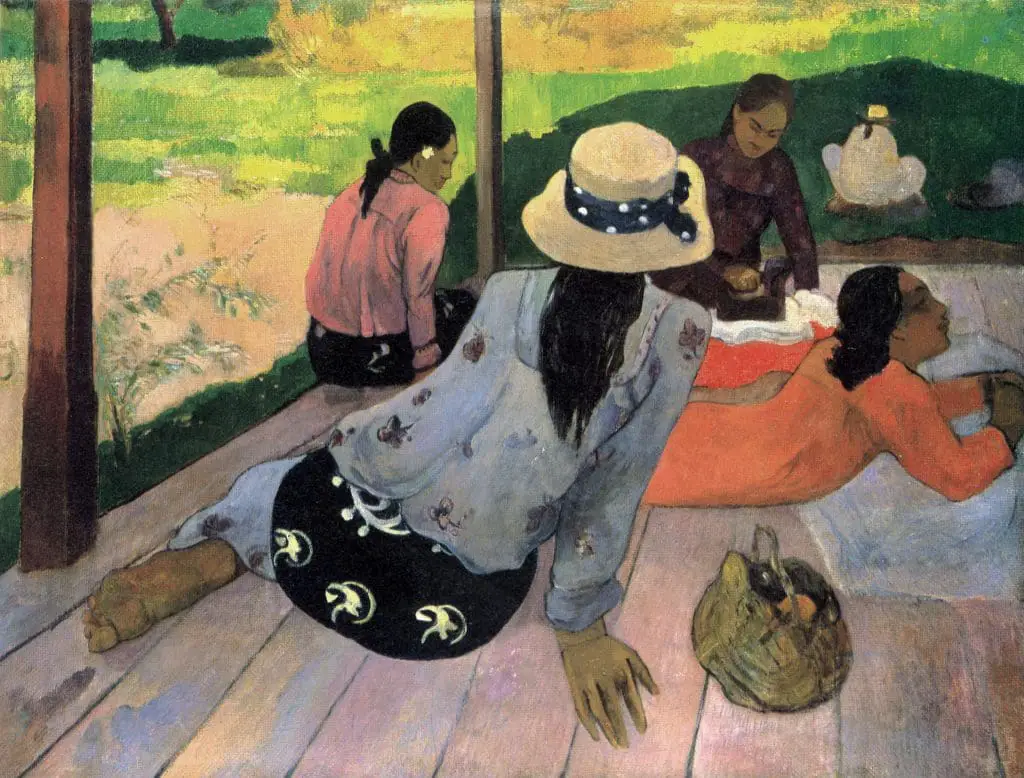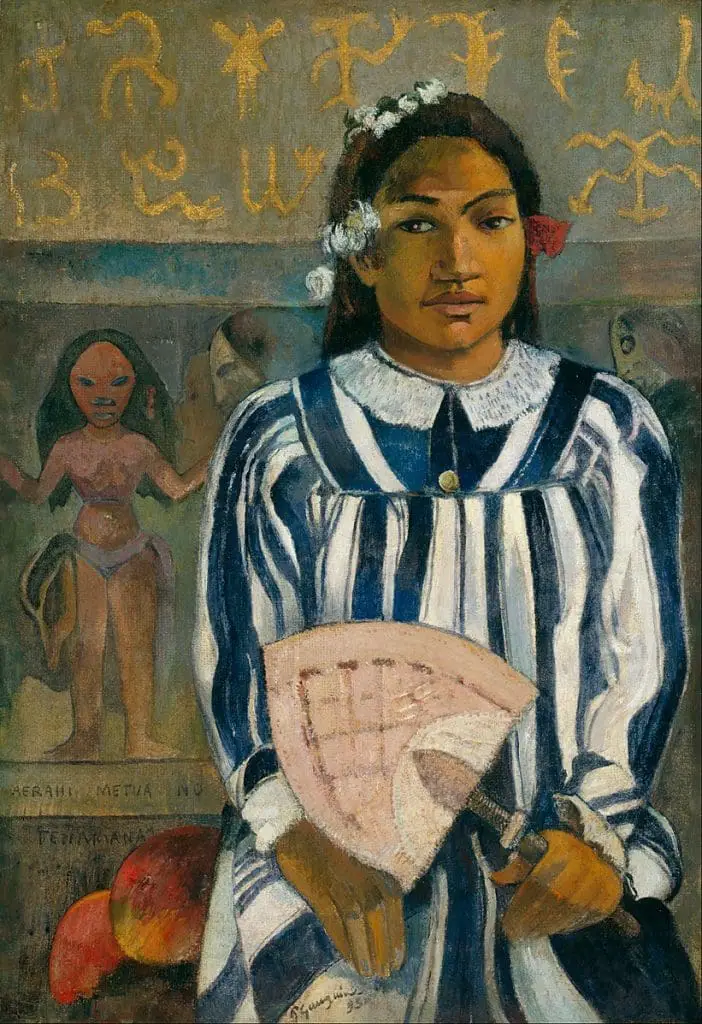Paul Gauguin was a very influential artist in the post-impressionism period. Like Vincent van Gogh, he was never truly appreciated until after his death. Paul Gauguin’s life was controversial.
Paul Gauguin is considered one of the best Post-Impressionism artists of all time. He is best known for many of his artwork about French Polynesia. Paul’s life was also riddled with controversy in how and how he lived and died.
Table of Contents
- About Paul Gauguin
- Gauguin and Van Gogh And The Yellow House
- Gauguin in French Polynesia and his death
- Frequently Asked Questions
- Related Questions
About Paul Gauguin
Paul Gauguin was born in Paris in 1848. He was born during the time of the revolutionary upheavals in Europe. As his father was a journalist, his family needed to flee to France.
In 1850, Paul’s father and mother, with his sibling, decided to go to Peru, so his father could hopefully continue his journalism career. Luckily, his father died because of a heart attack en route, so his mother, Alene, arrived in Peru as a widow with an 18-month-old Paul and his two 1/2-year-old sisters, Marie.
Paul had a privileged and ideal childhood in Peru with nursemaids in servants. But in 1850, that all changed due to some Peruvian civil unrest, so Alene returned to France with her children.
Paul was educated in France and eventually ended up as a merchant marine. He joined the French Navy and traveled worldwide; in 1871, he returned to Paris and secured a job as a stockbroker. When he was just 23 years old, he became a successful businessman and remained successful for the next 11 years.
While working as a stockbroker, he married his first wife, a Danish woman, Mette-Sophia Gad in 1873. Over the next ten years, they had five children.
In 1880, the Paris stock market crashed, and Paul’s earnings deteriorated distinctly, so he decided to pursue painting art full-time; in 1884, he moved with his family to Copenhagen.

Art and The Break Up of His Family
After 11 years of marriage, his family life fell apart when Paul painted full-time. He returned to Paris in 1885 after his wife and her family asked him to leave because they said he had renounced their shared values. His last physical contact with his family was in 1891, and his wife eventually broke up with him in 1894.

When Will You Marry?
by Paul Gauguin
Gauguin and Van Gogh And The Yellow House
Many people know Paul Gauguin as the artist who lived with Vincent van Gogh. In 1888, in a yellow house in Southern France, Vincent van Gogh and Paul Gauguin shared a house as post-impressionist painters.
The two-story yellow house where they once lived no longer exists, but it has been immortalized several times in paintings by van Gogh, including the yellow house in 1888 and the bedroom he also painted in 1888.
Van Gogh’s dream was to establish what he called the studio of the South; this would be where artists could live and collaborate with fellow painters while they went out to study the surrounding countryside. Paul Gauguin accepted Vincent van Gogh’s invitation because he was promised financial support from the art dealer’s brother, Theo. At that time, Theo was an influential art dealer in Paris.
The relationship between Gauguin and Van Gogh was troubled from the very beginning. For Paul Gauguin, it was not so much about having an artistic collaboration to receive financial support from Theo, Vincent Van Gogh’s brother.
In this house, due to the stressful relationship between these two artists, Van Gogh mutilated and cut off his left ear in a fit of rage; he also threatened Paul Gauguin. Gauguin swiftly got on a train to Paris, and the two never saw each other again, though they did correspond some.

Gauguin in French Polynesia and his death
Paul Gauguin spent a lot of time in French Polynesia. He is probably most well known for saturated colors and vivid depictions of life in the French Polynesia islands.
French Polynesia also showed Gauguin’s controversial sexual side. Paul Gauguin was thought by many to be a pedophile as he had several adolescent lovers and three or more children, brides. He was known to give syphilis to at least three of these brides during his time in Polynesia.
Paul Gauguin used many adolescent women in Polynesia as both models and mistresses. In 1891, before he was officially divorced from his first wife, he married Teha’amama on his first trip to Tahiti. By 1893, they were separated. Eventually, he returned to France.
In 1895, he decided to go back to Tahiti again when he had a relationship with Pahura, who was just fourteen and a half years old when they started their sexual relationship. He fathered two children with her; their daughter died in infancy, and the son survived.
Gauguin wanted to live in the Marquesas, but Pahura refused to go and leave her family behind. So Gauguin went by himself to Marquesas. Gauguin’s son was raised in Tahiti by Pahura.
Gauguin moved to Marquesas in 1901. While in Marquesas, Gauguin took another young girl named Vaeoho or Marie-Rose; she was only fourteen years old at that time.
In 1902, when Vaeoho was seven months pregnant, she decided to go back to her home to give birth to her baby so she could be around family and friends. She gave birth to their daughter but never returned to live with Gauguin.
Due to his syphilis, Gauguin had sores all over his body that required daily cleaning and care. Vaeoho essentially became both his mistress and nursemaid; it must have been hard work for a young girl who was also pregnant.
Paul Gauguin was in declining health and extreme pain. He was using morphine and died alone on the 8th of May 1903. As he did not have a will, many of his artwork, papers, and other things in Polynesia were auctioned off or destroyed.
In Polynesia, he is buried at the Catholic Calvary Cemetery (Atuona Hiva’ Oa).
Gauguin was a very controversial figure for his art and especially for the kind of life that he led. Besides the women, he had mistresses all over France and French Polynesia; he had several children with women in Europe.
Like Van Gogh, Gauguin’s artwork started to be appreciated after his death. His paintings are now considered extremely valuable, and he is regarded as one of the great artists of the time. Gauguin also gave us some great insight into life in French Polynesia when he lived there.
Great paintings and artists like Paul Gauguin inspire me. Anita Louise Art is dedicated to art education, great artists, and inspiring others to find and create their art. We love art that uplifts and inspires. #ArtToMakeYouSmile! #ArtToMakeYouHappy!
Anita Louise Art is dedicated to art education, great artists, and inspiring others to find and create their art. We love art that uplifts and inspires. #ArtToMakeYouSmile! #ArtToMakeYouHappy!
If you are interested to see any of my art, you can find out more by clicking here. If you are interested in what inspires me and my paintings, you can discover more by clicking here.
We have a free newsletter and would love you to be part of our community; you can subscribe to the newsletter by clicking here. If you have any questions, I would be happy to talk to you at any time. You can reach me, Anita, by clicking here.
Subscribe to our Anita Louise Art YouTube Channel filled with great videos and information by clicking here.
Join us for our podcast “5 Minutes With Art.” Spend just 5 minutes a week with us to discover and learn about great art and artists. You can find out more about our podcast by clicking here.
Frequently Asked Questions
Who was Paul Gauguin?
Paul Gauguin was a French Post-Impressionist artist who lived from 1848 to 1903. He is best known for his paintings of the Tahitian people and landscapes
What was Gauguin’s painting style?
Gauguin was a Post-Impressionist painter who was known for his bold use of color, flat shapes, and simplified forms
What was Gauguin’s personal life like?
Gauguin had a controversial personal life, which included abandoning his wife and children, living with teenage girls in Tahiti, and contracting syphilis.
What was Gauguin’s relationship with Vincent van Gogh?
Gauguin had a tumultuous relationship with Vincent van Gogh, which culminated in a violent altercation in which van Gogh cut off his own ear.
What is the controversy surrounding Gauguin’s relationship with the teenage girls he lived with in Tahiti?
Some critics have accused Gauguin of exploiting the young girls he lived with in Tahiti, while others argue that his relationship with them was consensual and that he provided for them financially.
Was Gauguin influenced by Japanese art?
Yes, Gauguin was influenced by Japanese art, particularly its use of flat shapes and simplified forms.
What is the controversy surrounding Gauguin’s depiction of the Tahitian people?
Some critics argue that Gauguin’s depiction of the Tahitian people is romanticized and eroticized, while others argue that he was genuinely interested in and respectful of their culture.
What is the significance of Gauguin’s use of color in his paintings?
Gauguin’s use of color was revolutionary for his time, and his bold, bright palette had a significant impact on the development of modern art
Related Questions
What Was The Impact Of Vincent Van Gogh On The Art World?
Van Gogh used color, form, and emotions in his art. He had a bright palette that was individualized for his time. Even though he did not see a lot of success during his life after he died, the impact of his art can be seen in both the Expressionism and Fauvism movements that were taking place in Europe.
By clicking here, you can learn more by reading What Was The Impact Of Vincent Van Gogh On The Art World?
Why Is Van Gogh Considered Such a Great Artist?
Many things make Vincent Van Gogh unique and great as an artist. He had a great way to use color in his heart, but more than that, he was an artist who set and paved the way, and his brushstroke technique used color and his design ability. What is interesting about all this he did this as a self-taught artist.
By clicking here, you can discover more by reading Why Is Van Gogh Considered Such a Great Artist?

